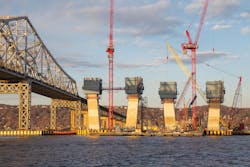Aided by a mild winter, the replacement of the aging Tappan Zee Bridge just north of New York City is moving forward at a very rapid clip.
At $3.98 billion, the new crossing is the largest active-construction highway or bridge project in the U.S.
The first span of the New York State Thruway Authority’s new bridge is scheduled to open in mid-2017, with the second crossing opening in 2018. In contrast to its predecessor, the new twin-span structure will last at least a century without major structural maintenance. More capacity, the addition of breakdown lanes and state-of-the-art traffic monitoring systems will mean less congestion and safer movement for all travelers. The bridge also will feature a bike/pedestrian path and is designed to accommodate bus rapid transit, light rail or commuter rail in the future.
High horizontal
As Tappan Zee Constructors LLC (TZC), the project’s design-build consortium, advanced the project over the past year, the job’s orientation shifted from primarily vertical to primarily horizontal work. While the first two years saw construction of most of the substructure work on the project, including piles and pier columns, work by the middle of 2015 turned increasingly to erecting giant blue steel girder assemblies and installing concrete deck panels atop the beams. (A second but significantly smaller phase of substructure work will commence near both shorelines after traffic is moved onto the first span of the new crossing and the existing bridge is demolished). The impressive momentum positions the project well for continued rapid progress during 2016 and beyond.
The crossing’s new profile is increasingly coming into focus as more and more girders are lifted into place. Looking ahead, 36,000 tons of the eventual 100,000 tons of girders will be installed in 2016.
The scale of the girder assemblies is nothing short of breathtaking. With the distance between pier caps extending as far as 410 ft—greater than the distance from home plate to the centerfield wall in most Major League Baseball stadiums—the assemblies are being lifted into place by one of the largest and most powerful barge-based cranes in the world, the I Lift NY super crane. Viewing their length another way, if a National Football League running back ran the length of the longest assembly in every game of a season, he would break the NFL rushing record of 2,105 yards.
After installing the initial girder assemblies, the team began placing the first sections of road deck in October 2015. Resting on the assemblies, the new bridge’s steel-reinforced concrete deck panels weigh as much as 74,000 lb each, are 12 ft long, range between 22 and 45 ft wide and are nearly 11 in. thick. When fully assembled, the deck panels will comprise a surface area of more than 65 acres—approximately equal to the deck space of all 19 U.S. Navy aircraft carriers currently in service.
Additionally, work began in August 2015 on the bridge’s iconic towers, which will support the main span over the Hudson River’s navigation channel. Utilizing self-climbing jump forms, work crews are assembling the H-shaped towers in continuously rising segments through summer 2016 when they will reach their full height of 419 ft, more than a third taller than the Statue of Liberty.
Top: Precast concrete deck panels began to be placed in summer 2015 atop the steel blue girder substructure of the bridge.
Middle: Piers rise out of the Hudson.
Bottom: Girders shoot over a local train corridor.
As the towers near completion, TZC will begin the process of stringing 14 miles of steel cables from the towers to attach and support, or stay, the decks of the main spans of the new cable-stayed bridge. More than 190 cables will connect the eight towers to the main span bridge sections, covering an area measuring more than 2,200 ft long on each of the twin bridge structures.
On land, the project team is taking steps toward eliminating the hassle of stopping or slowing down to pay tolls through the use of an overhead all-electronic toll collection (AETC) system. Starting this spring, a temporary gantry erected near the western shore of the bridge will allow motorists to pay their toll at highway speeds via E-ZPass or Toll-by-Mail. The temporary AETC facility will be employed until a permanent one is built on the location of the existing plaza near the eastern shore. The new facility will mirror the lanes of the New York State Thruway, greatly reducing the physical footprint of the existing 12-lane toll plaza.
With an extensive armada of marine vessels, including floating concrete batch plants and numerous cranes headlined by the I Lift NY super crane, continued rapid progress will be achieved on the new bridge’s girders, deck, towers and landside elements during the remainder of 2016 and beyond. R&B



